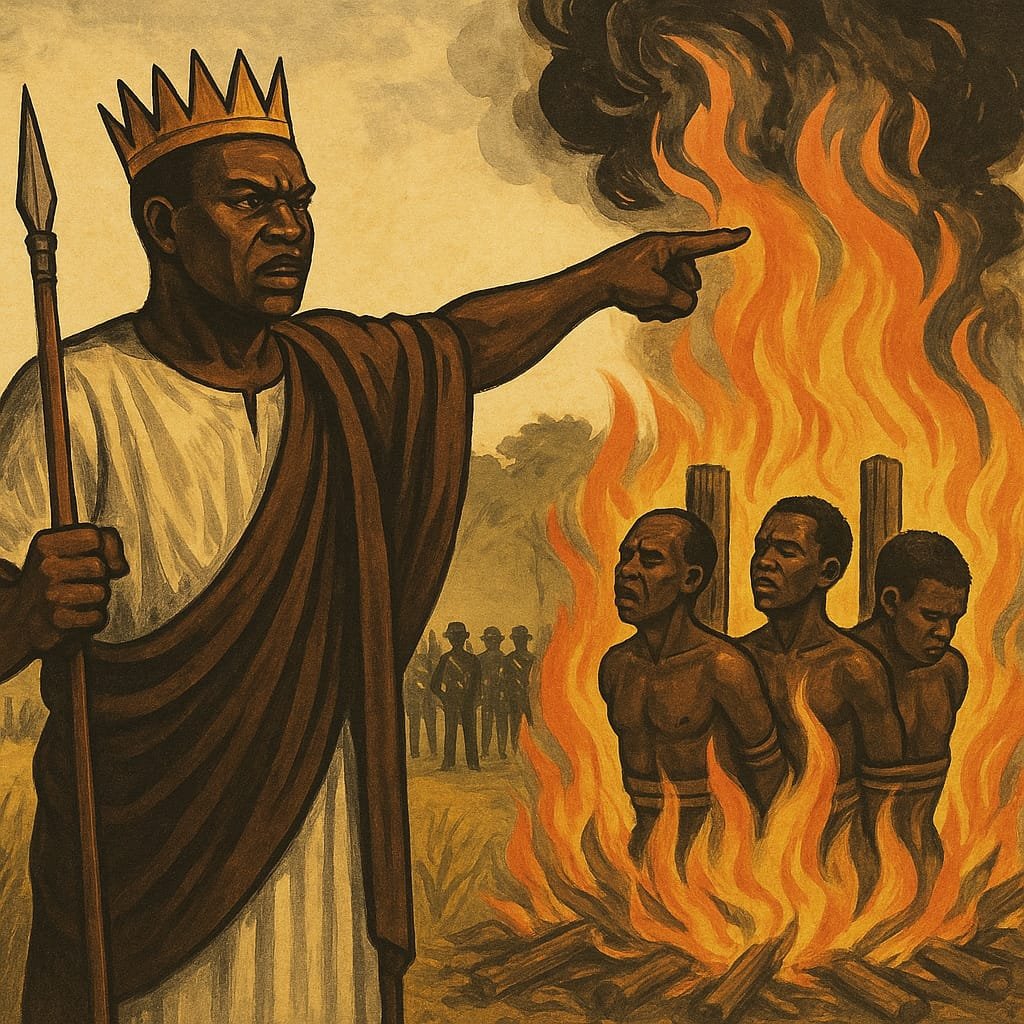By Isaac Christopher Lubogo
I. Introduction: A Day Revered, A Truth Untouched?
Every 3rd of June, Uganda halts in reverence. Millions—pilgrims, tourists, politicians, and opportunists alike—flock to Namugongo to commemorate Uganda Martyrs’ Day. It is billed as a sacred day of national religious identity and pride. But underneath the pageantry of marching bands, pork-laced barbecues, loud music, miracle water sales, and miles-long pilgrimages, lies a rarely interrogated question: Was the martyrdom story we inherited wholly true? Or, more provocatively, was it a colonial inversion of events aimed at sanctifying collaborators and demonizing African resistance?
II. The Widely Accepted Narrative: A Closer Look
The standard narrative holds that between 1885 and 1887, Kabaka Mwanga II of Buganda ordered the execution—mostly by fire—of 45 Christian converts (23 Anglicans, 22 Catholics), accusing them of refusing to renounce Christianity and resisting his homosexual advances. This tale, especially the claim that they refused to be sodomized by the king, has been broadly repeated in schools, churches, and literature without much interrogation.
However, this narrative appears increasingly simplistic—and perhaps even strategically fabricated.
III. The Political Context: Buganda as a Battleground of Interests
In the late 19th century, Buganda was not merely a tribal kingdom but a geopolitical chessboard caught between Arab traders, British imperialists, German agents, and Christian missionaries. Mwanga inherited not just a kingdom, but a battlefield of ideologies and foreign influences. His father, Kabaka Muteesa I, had already played Anglican, Catholic, and Muslim missionaries against each other as a strategy of survival. He invited missionaries but remained ideologically noncommittal—until he reportedly executed some converts himself at Namugongo prior to Mwanga, a fact often erased or downplayed (Ref: Kiwanuka, M.S.M., A History of Buganda).
Thus, Namugongo was already a site of execution under Muteesa I, likely for political and not purely religious reasons.
IV. Missionaries, Espionage, and the Conversion of Royal Pages
Let us examine the individuals canonized as martyrs. Many were pages in the Kabaka’s palace—young boys placed under intense missionary influence. Their names reveal foreign affiliations:
Charles Lwanga (Anglicized name: Charles—clearly Western, Lwanga possibly derived from Rwanga, meaning to “lead or command” in some Bantu dialects, suggesting he was seen as a ringleader).
Joseph Mukasa Balikuddembe (Mukasa being a traditional spirit god’s name, but Joseph clearly a missionary implant).
Andrew Kaggwa, Denis Ssebuggwawo, Mbaga Tuzinde, etc.—all with Western first names tagged to Buganda surnames.
These boys were not just converts—they were cultural double agents, intentionally groomed by missionaries (both Protestant and Catholic) as insiders to the Kabaka’s court. They relayed internal palace secrets, interfered with palace operations, and arguably acted as political threats under the guise of religion.
In fact, some missionary letters reveal their zeal in “capturing souls” as a form of spiritual conquest, noting with pride how they had “planted the seeds of the Gospel within the palace itself” (Ref: White Fathers Correspondence, 1885).
V. Were They Killed for Faith or Treason?
It is plausible that Mwanga did not see them as martyrs of faith but rather subversive elements collaborating with colonial agents. This interpretation is supported by the fact that many were executed not immediately after their conversion, but after being caught smuggling palace secrets, defying orders, or openly challenging the king’s authority—not merely for refusing sodomy.
The narrative of sexual refusal conveniently moralizes their defiance and demonizes Mwanga as a deviant tyrant. But what if that part was later added by European chroniclers to generate Western sympathy and justify colonial intervention?
In fact, the “sodomy accusation” aligns perfectly with Victorian colonial propaganda—Africans being portrayed as savage, irrational, and sexually immoral. (Ref: Empire and Sexuality: The British Experience by Ronald Hyam).
VI. The Invisible Martyrs: Muslims and Protestants
Interestingly, the public narrative disproportionately emphasizes Catholic martyrs, yet:
Protestants were numerically more (23 Protestants vs. 22 Catholics), but are barely acknowledged in national commemorations.
Even more overlooked are Muslim martyrs, who were killed during the earlier religious purges in the 1870s and 1880s. Muslim converts suffered under both Muteesa I and Mwanga, yet Namugongo is not branded as their shrine.
This skewing suggests that Martyrs Day is not truly about honoring all religious courage—it is a deeply curated Catholic narrative, bolstered after the canonization by Pope Paul VI in 1964 and popularized to consolidate Catholic influence in Uganda.
VII. Martyrs Day Today: Commerce, Confusion, and the Crumbling Sacred
Namugongo today is a paradoxical spectacle:
“Holy water” collected from seasonal runoffs, with no purification, is sold to desperate pilgrims under claims of healing powers.
The area becomes a hub of unrestrained commerce—lodges turned into brothels, bars overflowing, pork stalls overshadowing prayer tents.
Pilgrims walk barefoot from as far as DR Congo and Kenya, convinced they will find miracles. But what do they return with? Often sunburn, dehydration, and poverty-induced delusion.
The genuine faithful—few and scattered—kneel in quiet prayer amid noise, smoke, and sin.
The commercialization of faith has overtaken the historical essence of sacrifice. The day now resembles a religious festival more than a sacred commemoration. It raises moral and theological questions: Where is the biblical justification for this form of veneration? Where is the national introspection?
VIII. The Myth of Redemption and the Mask of History
The Uganda Martyrs are not merely remembered—they are mythologized, perhaps falsely. Their canonization helped shape a new moral order that favored colonial dominance over African resistance. They became saints not just of the church, but of empire.
In truth, Mwanga may have been a tragic hero—a young king caught between preserving sovereignty and being labeled a brute. His resistance, however flawed, was genuine. And for that, history chose to crucify him.
IX. Conclusion: Reclaiming the Discourse
To question the Uganda Martyrs’ narrative is not to dishonor the dead—it is to demand historical integrity. We must reclaim the conversation from myth to truth, from religion to reality. Martyrs Day should not be a day of blind veneration, but of deep inquiry.
Who do we really honor when we kneel at Namugongo? Saints? Spies? Or a story carefully scripted for imperial interests?
Until we confront this alternative possibility, we risk worshipping illusion and baptizing manipulation as faith.
References (selective):
1. Kiwanuka, M.S.M., A History of Buganda: From the Foundation of the Kingdom to 1900, Methuen & Co.
2. Ronald Hyam, Empire and Sexuality: The British Experience.
3. J. V. Taylor, The Growth of the Church in Buganda.
4. J.S. Mbiti, African Religions and Philosophy.
5. Vatican archives on canonization of Uganda Martyrs (1964).
6. Correspondence from White Fathers Missionary Archives (Kampala & Algiers).
7. Jan Vansina, Oral Tradition as History – for understanding myth-making in African narratives.
About the author:
The author, Isaac Christopher Lubogo, is a Ugandan lawyer and lecturer








